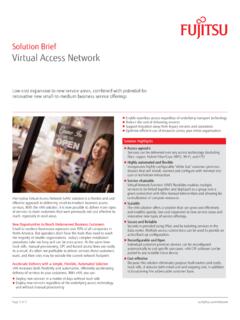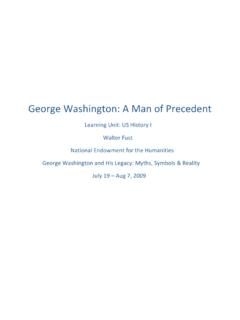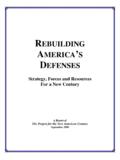Transcription of The Future of Urban Mobility 2 - UITP
1 Imperatives to shape extended Mobility ecosystems of tomorrowThe Future of Urban Mobility 2014 ContentForewords 31. Executive summary 52. Plotting the trend Urban Mobility systems are on their way to breakdown 93. Where are we now? Arthur D. Little Urban Mobility Index 114. What is holding back changes? Business models archetypes for Urban Mobility 225. Shaping the Future Strategic directions and imperatives for cities 276. Case studies of cities demonstrating good practices 51 Authors:Fran ois-Joseph Van AudenhovePartner, Arthur D. Little, BrusselsLaurent DaubyDirector Rail Transport, UITPJ r me PourbaixHead of Policy and Outreach, UITPO leksii KorniichukManager, Arthur D.
2 Little, FrankfurtAcknowledgement for their support and valuable input: Wilhelm Lerner (author of the first edition of the study), Ralf Baron, Aurelia Bettati, Marie Maggiordomo, Marc Durance, Lucie Lammens and Caroline Urban Mobility Index was developed by Arthur D. Little; the UITP is independent of this index, which does not necessarily reflect its opinion. Strategic imperatives for cities have been developed together with the UITP. 3 Mobility has significantly evolved in the past, under the influence of industrial evolutions. Following the first industrial revolution enabled by the invention of steam powered technology, the railway industry emerged.
3 The second industrial revolution with mass production enabled the emergence of the automobile industry and, closer to us, the third industrial revolution with digitalization enabled the emergence of computer-aided travelling (for example GPS in a car). Today we are entering what could be called a fourth industrial revolution, represented by industry and technology convergence, leading to the emergence of for example clean energy vehicles or connected Mobility solutions. This evolution is particularly noticeable over past years in network industries (such as telecommunication and media, utilities and the Mobility industry) as well as in B2C industries (such as retail and healthcare) where, driven by evolving customer needs and enabled by rapidly evolving technology, business models are continuously evolving.
4 In this new world, in order to meet the key challenges of today and the Future , organizations cannot only rely on optimizing their operations or pushing the next products generation to market. To be successful and meet evolving customer needs, they need to adapt to this new changing world by continuously finding ways to reinvent themselves. This successful transformation can only be enabled by system-level collaboration and a global management consultancy, linking strategy, technology and innovation, Arthur D. Little aims to help its clients succeed in this new world of innovation. The Future of Urban Mobility (FUM) Lab is our contribution to tackle the Urban Mobility challenge. With its FUM studies, Arthur D. Little aims to support cities and nations in shaping the extended Mobility ecosystems of tomorrow and facilitate an open dialogue between Urban Mobility stakeholders.
5 Our Mobility Lab initiative has reached a new dimension in 2013, with the signature of an exclusive partnering agreement with the International Association of Public Transport (UITP) for the co-development of Future of Urban Mobility studies; which in our view constitutes the ideal partner due to its global representation amongst Mobility actors and the depth of expertise of its practitioners in the field of Mobility . With the release of this second edition of the Future of Urban Mobility study, our aim is to provide Mobility decision-makers and stakeholders with reflections and guidance on devising sustainable strategies that are meeting current and Future evolving Mobility challenges. We hope you will find this report useful and we would be pleased to discuss its conclusions and the implications for your Garcia-Alves Fran ois-Joseph Van AudenhoveArthur D.
6 Little Global CEO Partner Forewords 4 The Arthur D. Little study The Future of Urban Mobility Towards networked, multimodal cities of 2050 had triggered the interest and attention of UITP when it was released in 2011; and for us it was natural to feature it in the main plenary session of our World Congress last May. When we were approached by Arthur D. Little to work together on a second edition of the study, the UITP immediately saw a great opportunity to further convey its own messages developed since 2009 in our PTx2 strategy, later labeled Grow with public transport .This strategy for the public transport sector sets out the ambitious aim to double the market share of public transport worldwide by 2025 and pinpoints the key areas where action is urgently needed.
7 Current trends indicate that more people will choose to use private motorized transport, leading to a staggering billion private motorized trips every day in cities of the world. If the world fails to change its Mobility habits, the Future of our planet looks decidedly bleak. By 2025, worldwide transport-related greenhouse gas emissions will be 30% higher than 2005 levels. Transport energy bills will also skyrocket and higher levels of energy consumption could pose a threat to global energy security. Traffic congestion will bring cities worldwide to a standstill. Most alarmingly, half a million people will be killed in road traffic accidents every , more and improved public transport offers a route to a better Future . By doubling the market share of public transport worldwide by 2025, cities will be able to boost growth, help fight climate change and create pleasant Urban environments where people and businesses can thrive.
8 Doubling the market share of public transport will enable the stabilization of Urban transport greenhouse gas emissions and energy consumption despite overall Mobility increase. In 2025, 60,000 lives will be saved, as a more balanced Mobility mix will lead to fewer Urban traffic fatalities. Doubling the market share of public transport would also create seven million green, local jobs. We took the city ranking proposed by Arthur D. Little as a starting point to perform and refine our analysis of today s Mobility situation in view of tomorrow s requirements. Cities are clustered around their development stage and are given a series of strategic recommendations to overcome current limitations to achieve the objective of networked Mobility .I would like to thank Arthur D. Little for their fruitful cooperation and welcome this joint effort by two prestigious and reputable organizations.
9 I hope that our joint study will inspire and help many decision-makers and FlauschUITP Secretary General 5 Arthur D. Little, the Global Management Consultancy, launched its Future of Urban Mobility lab in 2010 and in 2011 released its first global study highlighting the Mobility challenges cities face on a worldwide basis. This report introduced the first Arthur D. Little Urban Mobility Index, which assessed the Mobility maturity and performance of 66 cities worldwide, and triggered high interest within the Mobility industry and in the media on a global scale. January 2014 sees Arthur D. Little release the second version of the Future of Urban Mobility study, including an updated version of the Urban Mobility Index, with an extended scope of 84 cities worldwide as well as an extended set of criteria.
10 The index finds most cities are still badly equipped to cope with the challenges ahead indicating there is still significant potential for D. Little highlights what is holding cities back, and, together with its partner the UITP the International Association of Public Transport identifies three strategic directions for cities to better shape the Future of Urban Mobility . The study also describes 25 imperatives to consider when defining sustainable Urban Mobility policies and case studies of cities demonstrating good Executive Arthur D. Little Urban Mobility Index The most comprehensive global Urban Mobility benchmarking studyPlotting the trend Urban Mobility is one of the toughest challenges that cities face today as existing Mobility systems are close to breakdown. The world s population is increasingly city-based.






